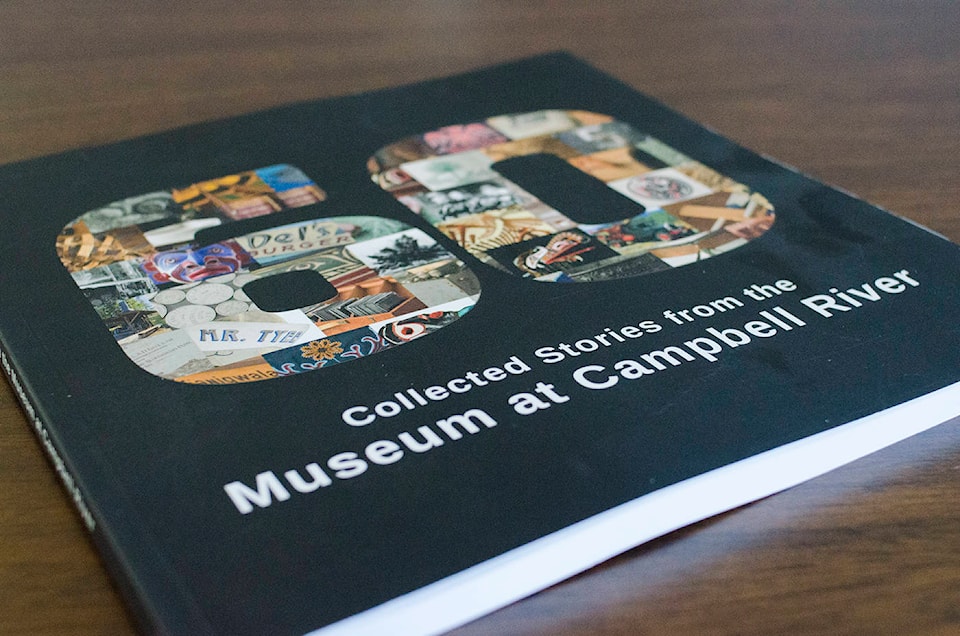“It’s not about the object. It’s about the story that the object tells.”
That’s how Jay Stewart, director at the Museum at Campbell River from 1977 to 1995 put it.
In other words, a museum isn’t really about the artifacts contained within it, it’s about the stories, people and communities those artifacts represent, reflect and embody.
And that was the idea driving a monumental undertaking by the Museum at Campbell River when curator Beth Boyce pitched it to the board of directors around this time last year.
“When she first brought it up, I have to admit, I thought, ‘wow, that sounds like a lot of work,’” says executive director Sandra Parrish. “But it did align really well with what we were planning in terms of our 60th anniversary exhibit, so we decided to just take the leap and do it.”
What they ended up with was more than they ever could have hoped for when that first conversation took place. The museum’s new book, 60: Collected Stories from the Museum at Campbell River, is exactly what it sounds like – a collection of stories based on 60 of the items in the museum’s collection.
But how do you possibly pick just 60 items from a collection of thousands?
“Well, I started by going through the minutes of every board meeting through the history of the Museum,” Boyce says, “which is actually way more interesting than you would think. I stopped when I got to the more modern ones, because they got really business-y and formal, but the early ones were like a gossip column. It was quite interesting and I learned a lot.”
Then, just this past January, the project really got underway.
“We just couldn’t narrow it down to the 60, which is why it took so long to really get started,” Boyce admits. “We kept changing our minds about which things needed to be included, because it really needed to both be reflective of the entire collection but also the history of the museum itself and how the collection and the museum developed over the years. We had to look at it from a lot of angles and everyone involved had personal attachments to their favourites. There were a few key things that were obvious – like the Steam Donkey, for example – but there was a lot of negotiating about the others.”
Then there was the driving force behind the concept: the stories themselves.
“There were some things that were really neat, but we just didn’t know enough about it to tell its story, so we just couldn’t include it,” Boyce says. “Because the idea wasn’t to just show off and say, ‘look at all the cool things we have here,’ it was about sharing the stories of those items and the people and communities behind them and how they came to be in the museum.”
Once they had the items selected, it was time to write those stories, so Boyce dug in and started crafting them in a way that would be interesting for people both familiar with the objects themselves and those who had no previous experience with them.
And, of course, they needed “book-quality” photographs of the items they were writing about.
“We needed the photos to be really nice, obviously, so we knew we couldn’t be the ones to take them,” Parrish says with a laugh. “So we brought Lee (Simmons) on board and he was just excellent to work with.”
Then they brought on local designer Lucilla Girotto to do the layout and Trevor McMonagle to do the editing.
“It was a real team effort and it was all done with locals,” Parrish says. “It was really great to work with all of these amazing people in creating what I think is a really valuable resource and addition to what the museum offers.”
But how to organize that effort into a cohesive book was another issue. They could organize them chronologically, by the age of the item, or they could organize them by ‘importance,’ but that would involve even more debate than the selection of the 60 items in the first place. They simply didn’t have time for that if it was to be published in time for their 60th anniversary celebration.
So because the book was also designed to tell the story of the museum itself – and not simply the stories of the items contained therein – the group organized the items chronologically, but not by the age of the items. Instead, the items were published in the order in which they were added to the museum’s collection.
“We thought that would help to show how the museum’s collection developed over the years, as well as its role within the community,” says Parrish.
“It also shows that these things are still out there, just waiting to be discovered and have their stories told, which is what makes the museum a living document, so to speak, because some of the oldest things in the collection are some of the newest things that have been added.”
“It makes it not only part of the living history, but also a look to the future,” McMonagle agrees. “It poses questions to which the answer is currently unknown, which is something that every museum piece should do. It should encourage future research, pose opportunities and instill the desire for more to be learned.”
60: Collected Stories from the Museum at Campbell River is only available at the museum itself, due to the small print run and tight margains on the $27.95 sale price, but they are happy to ship copies for those who would like them but can’t get to the museum to buy one.
Contact the museum at 250-287-3103 or head online to crmuseum.ca for more information on the new book or any of the programs or services the museum offers.
